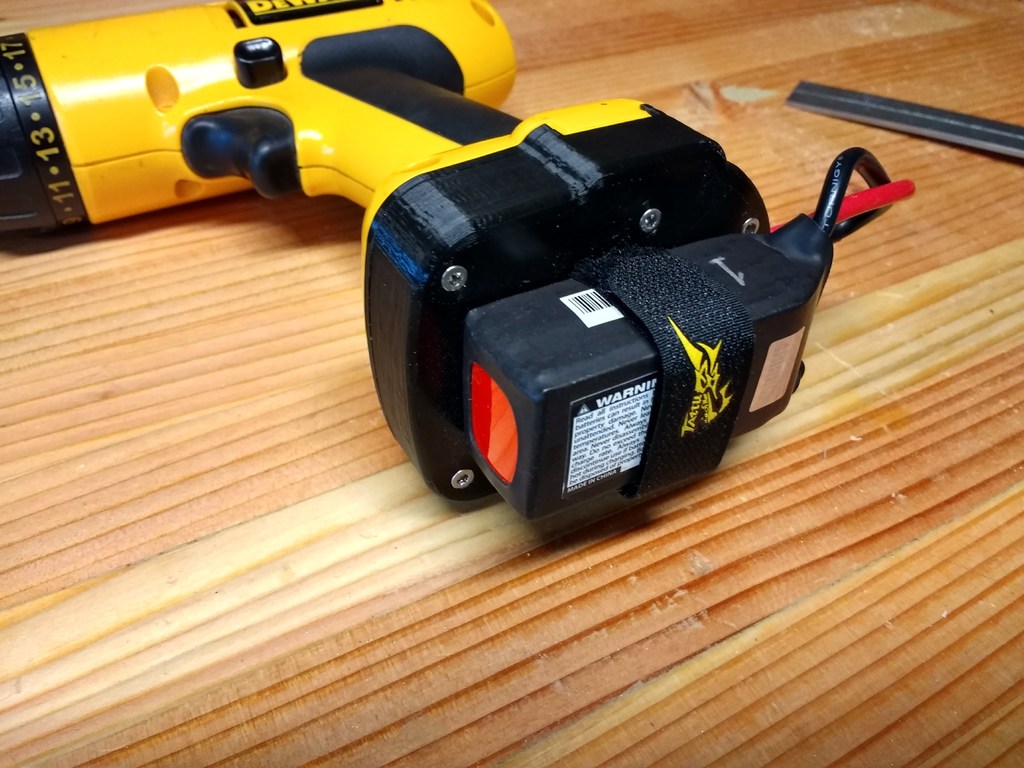
Dewalt 12v NiCd to XT60 adapter
thingiverse
I had an old Delwalt 12-volt drill with dead batteries and a bunch of 3S lipos from my early days in quadcopters so I figured I'd combine the two and have a functional drill again. The adapter is assembled onto the drill as the removable part is now the lipo battery. Everything prints without supports. The two clips are not exactly symmetric, so I marked them left and right as you would hold the drill in use. Looking at them with the drill upside down (as you're assembling the adapter) with the chuck pointing away, they will be "backwards," so the L is to your right and the R is to your left. Other hardware you'll need to assemble the adapter: About a foot of uninsulated 14-gauge household wiring. 7 M3x20 screws (the one that holds the retainer can be shorter). A male XT60 connector. A bit of copper-clad PCB (explained below). A velcro strap to hold the lipo. I included enough room in the cap for a low-voltage alarm. I made my own, but I think the cheap little battery checkers that you buy two for under $10 would work too. The bit of copper-clad is used to make a small retainer to prevent the XT60 from being pulled out when the lipo is removed. Cut it to the same dimensions as the XT60 and drill two holes for the XT60 solder lugs to fit in. These holes need to be snug. Then remove some copper between the holes so the two sides don't short. Place the XT60 in its position in the cap and solder the copper-clad to the lugs. You may also be able to just hot glue the whole thing, but I don't know how well that would hold up long-term. After printing the parts, the cap will have a layer in the screw holes that need to be removed. I include this bit so the part can print without supports and they're easy to remove with a small drill or a Xacto knife. To assemble the adapter first place the stem in place. Cut the household wire into two pieces and insert them into the holes in the stem. You should be able to feel them slide into the contacts in the drill. Once they come to a full stop, bend one to the left and one to the right. Screw the retainer in place, then bend both to the back of the drill close to the retainer. Bend the wire so they align with the middle of the drill and align with the solder lugs of the XT60. This is hard to describe, but easy to do. You can hold the XT60 lined up with the back of the drill to eyeball the location. There will be enough play that you don't have to be exact. Solder everything up and put a good coat of hot glue over the exposed wire to act as insulation. The hole nearer to the front of the drill is the positive lead. Now put the clips in by starting with them tilted at 45 degrees and rotating them into position. Put the lipo strap through the slots in the cap. Slide the cap over the XT60 and screw everything down. Don't torque the screws too hard since they're threading into the printed stem. And you're done. Before plugging in the battery, test to make sure there are no shorts! Also, it may be wise to add a snubber diode. I haven't added one; I'm assuming there's one in the drill already, but it wouldn't hurt to have another.
With this file you will be able to print Dewalt 12v NiCd to XT60 adapter with your 3D printer. Click on the button and save the file on your computer to work, edit or customize your design. You can also find more 3D designs for printers on Dewalt 12v NiCd to XT60 adapter.
